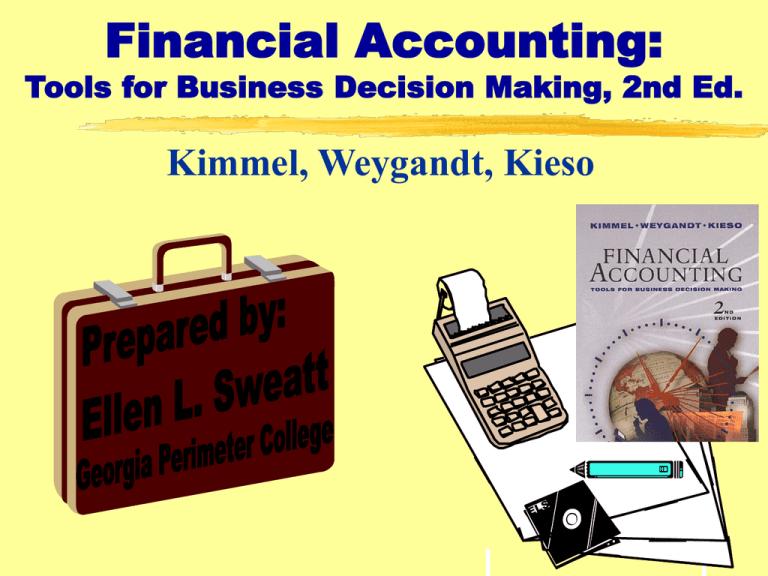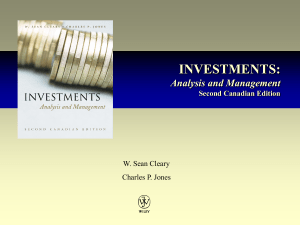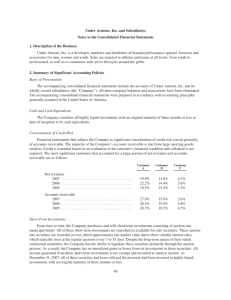
Financial Accounting:
Tools for Business Decision Making, 2nd Ed.
Kimmel, Weygandt, Kieso
1
Chapter
12
`
Chapter 12
Reporting and Analyzing
Investments
After studying Chapter 12, you should
be able to:
Identify the reasons corporations
invest in stocks and debt securities.
Explain the accounting for debt
investments.
Explain the accounting for stock
investments.
Describe the purpose and usefulness
of consolidated financial statements.
3
Chapter 12
Reporting and Analyzing
Investments
After studying chapter 12, you
should be able to:
Indicate how debt and stock
investments are valued and reported
in the financial statements.
Distinguish between short-term and
long-term investments.
4
Illustration 12-1
Temporary Investments
and the Operating Cycle
Illustration 12-2
Reasons Companies Invest...
Vertical and Horizontal
Acquisition
Vertical acquisition would
occur if Nike purchased a
chain of athletic shoe
stores.
Horizontal acquisition would
occur if Nike purchased
Reebok.
7
Debt Investments...
Are investments in government and
corporation bonds.
In accounting for debt investments,
entries are required to record:
the acquisition
the interest revenue
the sale
Are recorded at cost including
brokerage fees.
8
Debt Investments
Kuhl Corporation acquires 50 Doan, Inc.
12%, 10-year, $1,000 on Jan. 1 for $54,000.
Jan 1
Debt investments 54,000
Cash
54,000
To record purchase of 50 Doan, Inc. bonds
9
Bond Interest
The bonds pay interest of $3,000
semiannually on July 1 and January 1.
The entry to record the receipt of
interest on July 1 is:
July 1 Cash
3,000
Interest Revenue
3,000
(To record receipt of interest on Doan Inc.
bonds)
10
Accrued Bond Interest
If the buyer’s (Kuhl) fiscal year ends
on December 31, the following
adjusting entry is needed to accrue
interest of $3,000 earned since July 1:
Dec. 31 Interest Receivable
3,000
Interest Revenue
3,000
(To accrue interest on Doan Inc. bonds)
11
Bond Interest
Interest Receivable is reported as a
current asset in the balance sheet.
Interest Revenue is reported under
Other Revenues and Gains in the
income statement.
When the interest is received on
January 1, the entry is:
Jan. 1 Cash
3,000
Interest Receivable
3,000
(To record receipt of accrued interest) 12
Sale of Bonds
Kuhl sells the bonds for $58,000 on
January 1, 2002, after receiving the
interest due. *The bonds were purchased
for $54,000.
Kuhl must record a gain of $4,000. The
entry to record the sale of the bonds is as
follows:
1/1 Cash
58,000
Debt Investments
54,000
Gain on sale of Debt Investments 4,000
(To record sale of Doan Inc. bonds)
13
Stock Investments...
Are investments in the capital stock of
corporations.
When a company holds stock and/or debt of
several different corporations, the group of
securities is identified as an investment
portfolio.
The accounting for investments in common
stock is based on the extent of the investor's
influence over the operating and financial affairs
of the issuing corporation (the investee).
14
Stock Investments
Factors to consider in determining an
investor's influence are whether :
(1) the investor has representation on the
investee's board of directors.
(2) the investor participates in the investee's
policy-making process.
(3) there are material transactions between
the investor and the investee.
(4) the common stock held by other
stockholders is concentrated or dispersed.
15
Illustration 12-3
Accounting Guidelines Stock Investments
Cost Method
Under the cost method, the
investment is recorded at cost, and
revenue is recognized only when
cash dividends are received.
Cost includes all expenditures
necessary to acquire these
investments, such as the price paid
plus brokerage fees (commissions),
if any.
17
Acquisition of Stock
On July 1, 2001, Sanchez Corporation
acquires 1,000 shares (10% ownership) of
Beal Corporation common stock at $40 per
share plus brokerage fees of $500.
July 1
Stock Investments 40,500
Cash
40,500
(To record purchase of 1,000 shares of
Beal common stock)
18
Recording Dividends
A $2.00 per share dividend is received
by Sanchez Corporation on December
31:
Dec. 31
Cash (1,000 x $2)
2,000
Dividend Revenue
2,000
(To record receipt of cash dividend)
19
Sale of Stock
When stock is sold,
the difference
between the net
proceeds from the
sale (sales price less
brokerage fees) and
the cost of the stock
is recognized as a
gain or a loss.
20
Sale of Stock
Sanchez Corporation receives net proceeds of
$39,500 on the sale of its Beal Corporation
stock on February 10, 2002.
Since the stock cost $40,500, a loss of $1,000
has been incurred.
1/1 Cash
39,500
Loss on Sale of Stock
Investments
1,000
Stock Investments
40,500
(To record sale of Beal common stock)
21
Sale of Stock
A loss would be reported under
Other Expenses and Losses in
the income statement.
A gain on a sale would be
shown under Other Revenues
and Gains.
22
Equity Method...
Is an accounting method in which
the investment in common stock is
initially recorded at cost, and the
investment account is adjusted
annually to show the investor’s
equity in the investee.
23
Equity Method
Failure to recognize the
investors share of net
income until a cash
dividend is declared
ignores the fact that the
investor and investee
are, in some sense, one
company.
24
Acquisition of Stock
Milar Corporation acquires 30% of the
common stock of Beck Company of
$120,000 on January 1,2001.
Jan. 1 Stock Investments
120,000
Cash
120,000
(To record purchase of Beck common
stock)
25
Revenue and Dividends
For 2001 Beck reports net income
of $100,000 and declares and pays
a $40,000 cash dividend.
Milar is required to record:
(1) its share of Beck's income, $30,000
(100,000 x 30%), and
(2) the reduction in the investment account
for the dividends received, $12,000
($40,000 x 30%).
26
Revenue and Dividends
12/31 Stock Investments
30,000
Revenue from Investment
in Beck Company
30,000
To record 30% equity in Beck's 1998 net income
12/31 Cash
12,000
Stock Investments
12,000
(To record dividends received)
During the year the investment account has
increased by $18,000 ($30,000 - $12,000).
27
Holdings of More than 50%
A company that owns more than
50% of the common stock of
another entity is known as the
parent company.
The entity whose stock is owned by
the parent company is called the
subsidiary (affiliated) company.
28
Consolidated
Financial Statements...
Are usually prepared when a company owns more than
50% of the common stock of another.
Present the assets and liabilities controlled by the parent
company and the aggregate profitability of the subsidiary
companies.
Are prepared in addition to the financial statements for
each of the individual parent and subsidiary companies.
Are useful to the stockholders, board of directors, and
management of the parent company.
Inform creditors, prospective investors, and regulatory
agencies as to the magnitude and scope of operations of
the companies under common control.
29
Valuation And Reporting Of
Investments
Many argue that fair value - the amount for
which a security could be sold in a normal
market - offers the best approach because it
represents the expected cash realizable
value of securities.
Others contend that unless a security is
going to be sold soon, the fair value is not
relevant because the price of the security will
likely change again.
30
Valuation And Reporting Of
Investments
Debt and stock investments are
classified into the following three
categories:
Trading securities
Available-for-sale securities
Held-to-maturity securities
31
Illustration 12-5
Trading Securities...
Are securities bought and held
primarily for sale in the near term to
generate income on short-term
price differences.
Are reported at fair
value referred to as
mark-to-market
accounting.
Changes from cost
are reported in net
income.
32
Illustration 12-5
Available-for-Sale Securities...
Are securities that may be sold in
the future.
Are reported at fair
value.
Changes from cost
are reported in the
stockholders’ equity
section.
33
Illustration 12-5
Held-to-Maturity Securities...
Are debt
securities that
the investor has
the intent and
the ability to
hold to maturity.
More will be
covered in
advanced
courses.
34
Investment Portfolio
Under the accounting standards for
reporting investments in debt securities
and equity investments of less than 20%
that were introduced in 1993, companies
can choose which of the three categories
of securities to use for an investment.
Unfortunately, under these new standards,
companies can "window-dress" their
reported earnings results--that is make net
income look better than it really was.
35
Investment Portfolio
Gains and losses on investments classified
as available-for-sale are not included in
income, but rather are recorded an
adjustment to equity.
A company wanting to manage its reported
income can sell those available-for-sale
investments that have unrealized losses,
and not sell those available-for-sale
investments that have unrealized losses,
deferring the losses until a later period.
36
Temporary And Long-term
Investments
For balance sheet
presentation, investments
must be classified as either
temporary or long-term.
37
Temporary Investments
Short-term investments are securities
held by a company that are:
readily marketable - (can be sold easily
whenever the need for cash arises) and
intended to be converted into cash within the
next year or operating cycle, whichever is
longer.
38
Temporary Investments
Because of their high liquidity,
short-term investments (at fair
value) are listed immediately
below Cash in the current asset
section of the balance sheet.
39
Long-Term Investments
Long-term investments-are generally
reported in a separate section of the
balance sheet immediately below
Current Assets.
Long-term investments in available-forsale securities are reported at fair
value, and investments in common
stock accounted for under the equity
method are report at equity.
40
Gains and
Losses on Investments
Gains and losses on investments, whether realized
or unrealized, must be presented in the financial
statements.
In the income statement, gains and losses, as well
as interest and dividend revenue, are reported in
the nonoperating section under the following
categories:
Illustration 12-9
Other Revenue and Gains
Other Expenses and Losses
Interest Revenue
Loss on Sales of Investments
Dividend Revenue
Unrealized Loss--Income
Gain on Sale of Investments
41
Unrealized Gain--Income
Gains and
Losses on Investments
Earlier, it was noted that an
unrealized gain or loss on availablefor-sale securities is reported as a
separate component of stockholders'
equity.
Dawson Inc. has common stock of
$3,000,000, retained earnings of
$1,500,000, and an unrealized loss on
available-for-sale securities of
$100,000.
42
Gains and
Losses on Investments
Illustration 12-10
DAWSON INC.
Balance Sheet (partial)
Stockholders' equity
Common stock
$ 3,000,000
Retained earnings
1,500,000
Total paid-in capital
4,500,000
and retained earnings
Less: Unrealized loss on
(100,000)
available-for-sale securities
Total stockholders' equity
$ 4,400,000
43
Gains and
Losses on Investments
Note that the presentation of the loss is
similar to the presentation of the cost of
treasury stock in the stockholders' equity
section.
Reporting the unrealized gain or loss in the
stockholders' equity section serves two
important purposes:
It reduces the volatility of net income due
to fluctuations in fair value, and
It informs the financial statement user of
the gain or loss that would occur if the
securities were sold at fair value.
44
COPYRIGHT
Copyright © 2000, John Wiley & Sons, Inc. All rights reserved.
Reproduction or translation of this work beyond that permitted in
Section 117 of the 1976 United States Copyright Act without the
express written permission of the copyright owner is unlawful.
Request for further information should be addressed to the
Permissions Department, John Wiley & Sons, Inc. The purchaser
may make back-up copies for his/her own use only and not for
distribution or resale. The Publisher assumes no responsibility
for errors, omissions, or damages, caused by the use of these
programs or from the use of the information contained herein.
45







